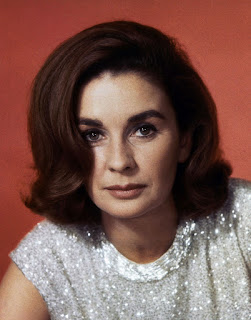Small roles in several other films followed including the high profile Caesar and Cleopatra, produced by Gabriel Pascal. Pascal saw potential in Simmons and in 1945 he signed her to a seven-year contract. Prior to moving to Hollywood, she played the young Estella in David Lean's version of Great Expectations (1946) and Ophelia in Laurence Olivier's Hamlet (1948), for which she received her first Oscar nomination. She played an Indian girl in the Powell-Pressburger film Black Narcissus (1947).
It was the experience of working on Great Expectations that caused her to pursue an acting career more seriously:
"I thought acting was just a lark, meeting all those exciting movie stars, and getting £5 a day which was lovely because we needed the money. But I figured I'd just go off and get married and have children like my mother. It was working with David Lean that convinced me to go on."
Playing Ophelia to Olivier's Hamlet made her a star while still in her teens, although she was already well known for her work in other British films, including her first starring role in the film adaptation of Uncle Silas, and Black Narcissus (both 1947). Olivier offered her the chance to work and study at the Bristol Old Vic, advising her to play anything they threw at her to get experience; she was under contract to the Rank Organisation who vetoed the idea. In 1949 Simmons starred with Stewart Granger in Adam and Evelyne. In 1950 she was voted the fourth most popular star in Britain. In 1951 Rank sold her contract to Howard Hughes, who then owned the RKO Pictures.
In 1953 she starred alongside Spencer Tracy in The Actress, a film that was one of her personal favourites. Among the many films she appeared in during this period were The Robe (1953), Young Bess (1953), Désirée (1954), The Egyptian (1954), Guys and Dolls (1955), The Big Country (1958), Elmer Gantry (1960), (directed by her second husband, Richard Brooks), Spartacus (1960), All the Way Home (1963) and The Happy Ending (1969), for which she received her second Oscar nomination. In the opinion of film critic Philip French, Home Before Dark (1958) saw her give '"perhaps her finest performance as a housewife driven into a breakdown in Mervyn LeRoy's psychodrama".
By the 1970s Simmons turned her focus to stage and television acting. She toured the United States in Stephen Sondheim's A Little Night Music, then took the show to London, and thus originated the role of Desirée Armfeldt in the West End. Performing in the show for three years, she said she never tired of Sondheim's music; "No matter how tired or off you felt, the music would just pick you up."
She made a late career appearance in the Star Trek: The Next Generation episode "The Drumhead" as a retired Starfleet admiral and hardened legal investigator who conducts a witch-hunt. In 1991 she appeared in the short-lived revival of the 1960s daytime series Dark Shadows, in roles originally played by Joan Bennett. From 1994 until 1998 Simmons narrated the A&E documentary television series, Mysteries of the Bible. In 2004 Simmons voiced the lead-role of Sophie in the English dub of Howl's Moving Castle.



























-large-picture.jpg)




BIG.JPG)







